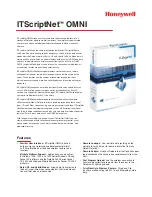
UAD Powered Plug-Ins Manual
- 296 -
Chapter 27: Lexicon 224
Lexicon 224
Buttons
Like the original hardware, UAD Lexicon 224 buttons are momentary-style
and don’t latch in a down position. When a function is unavailable within a
particular program, the button’s LED will not illuminate when clicked (the LEDs
also don’t illuminate for the increment/decrement buttons).
The first click of an increment/decrement button displays the current value of
the parameter; the value is actually changed only with subsequent clicks. This
feature enables viewing the current setting without changing it.
Tip:
For the inc/dec buttons (e.g., Reverb Diffusion), the value can be contin-
uously changed by holding the button down.
Lexicon 224
Sliders
The six sliders control the main reverb parameters within a program. These
are the most obvious controls to reach for when fine-tuning a reverb program
to best suit the material at hand.
In P9 Chorus A, the first four sliders don’t control the labeled parameters. See
“P9 Chorus A” on page 310
for descriptions of the sliders in this program.
Tip:
Clicking a slider “cap” will show its value in the Numerical Display.
Clicking the text label of any slider will return that slider to the default value
for the active program.
Inputs &
Outputs
The Lexicon 224 hardware has two inputs (see Mono/Stereo below), and
four discrete outputs, labeled as A, B, C, and D. Outputs A and C were de-
signed to be used as the main stereo left/right outputs. The other two outputs,
B and D, are implemented in some programs for use as quadraphonic reverb.
The UAD Lexicon 224 fully models the individual sonics of all four outputs
when available in the program algorithm. The alternate B and D outputs are
available via the
Rear Outs
control (
page 303
).
Note:
The dry signal at the Lexicon 224 output is completely unprocessed.
Mono/Stereo
Operation
The Lexicon 224 hardware has dual channel inputs (left and right) and is a
true stereo processor. Like the hardware, when the UAD Lexicon 224 plug-in
is used in a stereo-in/stereo out configuration, the left and right channel sig-
nals are both processed.
When used in a mono-in/stereo out configuration, the mono input is sent to
both channels of the stereo processor.
Содержание UAD
Страница 172: ...UAD Powered Plug Ins Manual 172 Chapter 12 Ampex ATR 102 Original Ampex ATR 102 Mastering Recorder Brochure ...
Страница 294: ...UAD Powered Plug Ins Manual 294 Chapter 27 Lexicon 224 Lexicon 224 Screenshot Figure 99 The Lexicon 224 plug in window ...
Страница 482: ...UAD Powered Plug Ins Manual 482 Chapter 47 Pultec and Pultec Pro Dip Response Figure 155 Pultec MEQ 5 Dip Response ...
Страница 497: ...UAD Powered Plug Ins Manual 497 Chapter 48 RealVerb Pro Figure 166 RealVerb Pro in Morphing mode ...
















































